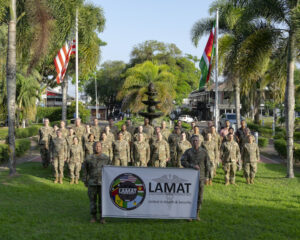
Courtesy Story
Air Force Medical Service
U.S. Air Force Reserve members have been integral to the Lesser Antilles Medical Assistance Team, or LAMAT, a U.S. Air Force medical assistance mission that complements care for patients across medical specialties in island nations in the U.S. Southern Command area of responsibility.
Air Force Reserve members traveled to Suriname, St. Lucia, St. Vincent and the Grenadines, and St. Kitts and Nevis starting in February, and over the span of eight weeks encountered diverse experiences and opportunities to increase readiness and support communities.
Air Force-led global health engagement, or GHE, activities are increasingly utilizing Total Force Integration, including active-duty and reserve component personnel and units. The Air Force Reserve’s support of LAMAT offers a powerful opportunity for practicing expeditionary medical skills and force retention. The overall mission enhanced U.S. Air Force and partner nation medical capabilities with more than 6,000 procedures performed on more than 3,500 patients.
Every year, Air Force Reserve members have two weeks of annual training focused on maintaining military medical readiness. GHE activities offer a unique opportunity for reserve medical Airmen enabling them to operate in new and austere environments, which strengthens their readiness for a wide range of potential future operations.
Col. Ann M. McCain, the command surgeon for the Air Force Reserve Command, stressed the advantage of GHE and how it aligns with the Air Force Reserve Command senior leadership’s vision of combat-ready Airmen.
“Participating in GHE provides our Reserve Airmen the opportunity to engage in medical humanitarian assistance efforts in underserved communities,” said McCain. “In addition, GHE provides a platform to increase the clinical currency, competency and medical readiness of our Airmen.”
During the LAMAT mission in Suriname, Staff Sgt. Jasmine Abalos, 349th Medical Squadron dental technician, Travis Air Force Base, California, accomplished skills sustainment requirements as part of the comprehensive medical readiness program. Abalos worked with Reservists from various bases and built relationships with partner nation counterparts. She emphasized the importance of Reserve participation in GHE and how it can support force retention by providing novel experiences for Reservists, which is an important factor in medical force readiness.
“Participating in the LAMAT mission was something I looked forward to. It was exciting to have a new experience where I was immersed in a different country with diverse resources and individuals,” said Abalos. “Serving as a Reservist on this mission has pushed me to enhance my skills as an Airman and has provided invaluable preparation for potential future deployments. I believe that the presence of [Air Force Reserve] members in GHE efforts is crucial for maintaining readiness and skill proficiency as well as keeping our forces excited about the mission.”
Capt. Miranda Schmidt, 349th Aeromedical Staging Squadron pediatric intensive care unit nurse, explained that Air Force Reserve members offer a unique capability to the GHE featuring a compliment of skillsets they learn while balancing their civilian and military careers.
“As Reservists, we have three main roles: our military duties, our civilian jobs, and our family responsibilities. Because of this, we are skilled in managing multiple tasks and have a greater understanding of the bigger picture,” Schmidt said.
While working in the pediatric intensive care unit in Suriname, Schmidt provided care to a three-week-old patient who had been in the intensive care with a heart condition since birth. While working alongside providers and providing education to families in Suriname, Schmidt offered tools to impact the child’s continuum of care while enhancing cross-cultural communication skills.
“During the last day of the mission, I provided extensive education to the family which helped the parents understand their child’s care and allowed them to gain more confidence. The most profound moment was when I assisted them in holding their baby for the first time. Setting them up for success for their future was truly rewarding,” said Schmidt.
In addition to facilitating knowledge exchange, interoperability and the demonstration of Air Force Reserve involvement, the LAMAT mission also serves as a platform for Air Force Reserve members to cultivate relationships and skills.
“I am grateful for the opportunity to have participated in LAMAT,” said Schmidt. “Looking ahead, I am enthusiastic about future GHE opportunities. By consistently supporting our global partners, we bolster force retention and fuel the passion within Reservists to remain prepared and eager to serve.”
The LAMAT mission concluded in March, providing medical support to four locations in the Caribbean and collaborating with U.S. partner nation counterparts in health, humanitarian aid/disaster relief, and security cooperation.